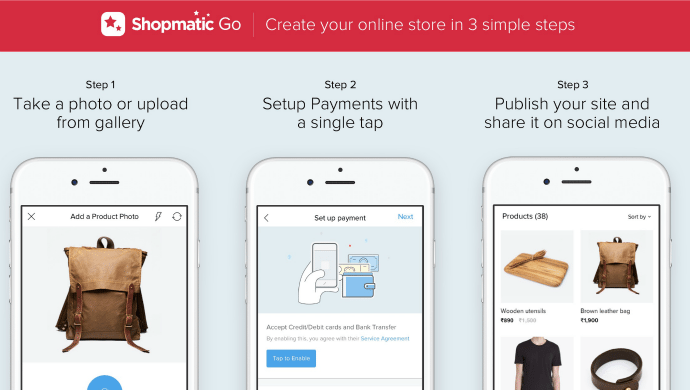Shopmatic is a DIY platform that enables SMBs and individuals to build their own webstores in a few steps

For any B2B company, India is an intriguing market. With over 50 million small and medium businesses (SMBs), the country is far ahead of any other developing economies in terms of opportunity, but a large chunk of the market still remains untapped. While various B2B companies boast of huge marketshare in India, the reality is that SMBs market, by and large, remains untouched.
Can Singapore-headquartered Shopmatic make a difference? We threw this question at Anurag Avula, Co-founder and CEO of the India- and Singapore-based e-commerce enabler. “Education and awareness are the key to penetrating the SMB market,” was the reply.
e27 sat with Avula to know more about the intricacies of the India market and Shopmatic’s growth from a small startup to a 50,000-client company within two years of launching its operations.
Edited excerpts are below:
There are quite a few firms, including Bertelsmann-backed KartRocket that provide customised webstores to SMBs. What is the relevance of Shopmatic then?
There are many things that Shopmatic does differently from competitors to make things easy for Indian SMBs and individual entrepreneurs. Firstly, we enable the entire ecosystem for anyone wanting to sell online. We provide everything from free domain names to clickable, beautiful templates for building customisable stores. We also set up payments and shipping for domestic and international selling and have tied up with partners, so customers don’t have to run around assessing partners.
We also negotiate the best rates with our partners and offer them on to our merchants. We also help our merchants list their products on marketplaces like Amazon and eBay, in case they wish do so, as well as on social media like Facebook.
We don’t expect our merchants to have any technical know-how for creating webstores. We have actually designed our product to ensure that every aspect of this spells ease for the customer.
Also Read: Times Internet acquires DIY e-commerce enabler Get Me A Shop
Unlike others, we don’t bring a customer into our platform and leave them confused on what to do next. We have our dedicated teams calling, mailing, screen sharing, consulting with these merchants — so that their online journeys are made really easy.

Shopmatic Co-founder and CEO Anurag Avula
We don’t have a layered pricing model. Every customer can experience every aspect of our product mix, no matter what pricing plan she/he opts for. Plus, no one can really come close to our pricing plans. We charge just US$20 per month for merchants in India and US$30 per month for merchants in Singapore and Hong Kong.
Do you also enable digital payments as well as logistics solutions, which are a hard nut to crack?
Yes, we provide everything that a person needs to create a unique identity for herself online.
Once you sign up with Shopmatic, you can simply start using our do-it-yourself (DIY) platform to select from a set of 70-plus design templates to build your site. We provide a clear on-boarding flow for our merchants to be given a walk through or our product, so that they don’t have to worry about what step comes when.
Everything is designed in a manner that you can click and edit your way through the site. For example, you can click on an existing picture on a particular template that you choose, and that picture can be replaced by one of your own. You can choose a free domain name, that is unique to your business.
We help you enable payments with the click of a button, with our domestic and international partners like PayPal and CitrusPay. We also help you enable shipping for domestic and international selling.
All our templates are SEO-enabled and optimised for perfect views across devices like tablets, phones, and desktops. You don’t need to spend extra money in getting that done.
And, if you want to expand your customer outreach by selling on marketplaces and social media, we also help you with that by listing your products on Amazon, eBay and Facebook. Any person building their site through Shopmatic gets the added benefit of being able to see all sales through one single dashboard. We also help provide insights to merchants on how they can sell online.
India has over 50 million SMBs, but no companies have been able to crack the market yet. What has been your experience?
There are more than 51 million SMBs in India, but a very small percentage (less than 5 per cent) of them have gone online with their own web presence. If you keep SMBs aside, there are countless Indians/individuals across the world, who have some talent, interest, or passion that could be promoted online. The aunty that makes pickle, the mom that bakes the best cakes, the student that gives the best guitar tuitions, the working professional who is also a great photographer, the retired uncle who can teach math really well, people like you and me, all have some talent and passion that they can take online. If unleashed, it can give rise to huge opportunities for all.
While we enable the entire ecosystem for anyone wanting to take their business online, we believe there is an opportunity to create the category by opening up the ‘digital’ opportunity to audience set different from just SMBs/businesses.
India was chosen specially because there is a hunger in people here, to want to succeed. There is an openness to try out new things and there is a ‘let’s make it work’ attitude. We are ambitious enough in wanting to get it right in India, where others have failed. Which is why we have put in excessive effort in ensuring that every aspect of the product mix feeds off from customer sentiments and makes it really easy for all kinds of people to take their businesses online, and sell.
What are the some of the definite trends in the e-commerce services industry?
From our experience, we have seen that people are going through different learning curves. There are people who have sold/are selling on marketplaces and turning to us to help them build their sites, because they are tired of parting with high commissions/playing second fiddle to ‘other brands.’

(L-R) Shopmatic founders Kris Chen (CPO) and Yen Lim (COO) with Anurag Avula
There are also people who have seen social media as a catalogue service, but are having problems getting closure because the mediums are not e-commerce enabled, completely.
There are people who have built sites through other e-commerce platforms and are switching to us because they feel that they are duped with all the ‘additional’ costs they need to pay, and the fact that they need to hire third-party people to manage their sites.
So, we are happy to meet the needs of this disparate lot and offer them a superlative experience — where every possible barrier to adoption has been taken care of. We recently launched an app, Shopmatic Go, that allows you to build your site online, using your mobile phones in two minutes. And this is for free. It has seen a huge spurt of interest and we are already clocking 70,000-plus downloads in weeks.
Mobile-first and mobile-only are the new mantras for organisations, and web apps are expected to go obsolete over the coming years. How equipped are you to adapt to the changing environment?
Today, Shopmatic has two products in the market which offers a clear differentiation for us: Shopmatic PRO, a platform that enables the entire ecosystem for anyone wanting to sell online, that works on a US$20 a month subscription model, and Shopmatic Go, a mobile app, that is free and helps recruit newbies into the digital world.
What we are managing to now do with Go and Pro is manage merchants through their entire life cycle. For a first-time merchant who is tentative about the online world, we are offering him the familiarity of the phone that he is used to, to build out a webstore. So, our mobile app is the only app in the market that actually helps people create webstores using their mobiles by uploading their products, sharing them on social channels and enabling payments — all, in a matter of a few clicks. With Go, you can literally get a site up and running in two minutes.
For a person who is slightly more comfortable with the online world, they can choose PRO to help set up their stores — with much more functionality and features built in, than what Go has to offer.
You have bagged a total of 50,000 clients to date. How did you manage to win such a huge number within just two years of launching and with just US$1 million funding?
We actually launched just in January 2016. We have spent enough time listening to our customers and tweaking our product to suit their needs. As we speak, we have a huge number of customers coming in for both PRO and GO. And given the opportunity in the market, we have a long way to go.
Nowadays, many companies in both B2B and B2C segments have started integrating AI capabilities and chatbots to their platform. Do you also provide that?
No. What we’ve seen is that merchants get confused by many such features when they haven’t even got their basics right. We don’t want to confuse any one by giving them features that they may not even find the need to use.
Having said that, we have a robust product strategy in place and are constantly working on improvements and launching new things in the market- basis customer needs.
You delved into entrepreneurship quite late in your career. Any reasons for that? Do you think it is better to start up after gathering considerable experience?
I don’t think age has got anything to do with entrepreneurship. You can start building a business at any age.
Our plus point is that we have built a solid team of professionals with considerable years of experience across different domains. The quality of thinking that they bring to the table and the energy that they have, is unmatched, really.
—-
The post Meet Shopmatic, a B2B startup that enables 50K clients to build their own webstores appeared first on e27.